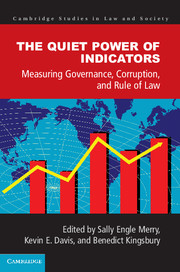Book contents
- Frontmatter
- Contents
- Notes on Contributors
- Acknowledgments
- Introduction: The Local-Global Life of Indicators: Law, Power, and Resistance
- PART I GLOBAL INDICATORS OF GOVERNANCE, CORRUPTION, AND RULE OF LAW
- Part II INDICATORS IN LOCAL CONTEXTS
- 6 Rule of Law Indicators as a Technology of Power in Romania
- 7 Indicators, Global Expertise, and a Local Political Drama: Producing and Deploying Corruption Perception Data in Post-Socialist Albania
- 8 Evaluating the Impact of Corruption Indicators on Governance Discourses in Kenya
- 9 Measuring Labor Market Efficiency: Indicators that Fuel an Ideological War and Undermine Social Concern and Trust in the South African Regulatory Process
- 10 Conclusion: Contesting Global Indicators
- Index
- Books in the Series
- References
8 - Evaluating the Impact of Corruption Indicators on Governance Discourses in Kenya
from Part II - INDICATORS IN LOCAL CONTEXTS
Published online by Cambridge University Press: 05 June 2015
- Frontmatter
- Contents
- Notes on Contributors
- Acknowledgments
- Introduction: The Local-Global Life of Indicators: Law, Power, and Resistance
- PART I GLOBAL INDICATORS OF GOVERNANCE, CORRUPTION, AND RULE OF LAW
- Part II INDICATORS IN LOCAL CONTEXTS
- 6 Rule of Law Indicators as a Technology of Power in Romania
- 7 Indicators, Global Expertise, and a Local Political Drama: Producing and Deploying Corruption Perception Data in Post-Socialist Albania
- 8 Evaluating the Impact of Corruption Indicators on Governance Discourses in Kenya
- 9 Measuring Labor Market Efficiency: Indicators that Fuel an Ideological War and Undermine Social Concern and Trust in the South African Regulatory Process
- 10 Conclusion: Contesting Global Indicators
- Index
- Books in the Series
- References
Summary
INTRODUCTION
International organizations, civil society, and governments of developed and developing countries alike have all declared war on corruption. In developing countries, corruption is seen as a major contributory factor to their failure to attain economic development. Indicators that measure corruption, or public perceptions thereof, have become a significant tool in this war. The indicators adopt various methodologies and are used for different purposes, including raising public awareness, advocating for institutional reforms, and assessing the extent to which such reforms are being implemented.
In Kenya, the government and Transparency International (TI)-Kenya now measure corruption annually, for different purposes. TI-Kenya produces an annual Bribery Index, which forms part of its efforts “to inform the fight against corruption with rigorous and objective research and analysis” (TI-Kenya 2006, 3). It has been producing the index since 2002. It has also been producing regional bribery indices since 2009. TI-Kenya sees the bribery index as a survey that “captures corruption as experienced by ordinary citizens in their interaction with officials of both public and private organizations” (TI-Kenya 2006, 3). It is compiled from information provided by respondents “on the organizations where they have encountered bribery during the year, where they paid bribes, how much and for what” (TI-Kenya 2006, 3). Respondents are also asked to assess the changes they have observed in these organizations. According to TI-Kenya, both the country and regional bribery indices are tools for measuring “petty bribery,” which it sees as “a general indicator for other forms of corruption in a particular country” (TI-Kenya 2010, 1). The Bribery Index has a value range from 0 to 100, where the higher the value, the worse the performance. The Bribery Index seeks to influence or shape discourses on governance, given that TI sees corruption as a manifestation of bad governance.
- Type
- Chapter
- Information
- The Quiet Power of IndicatorsMeasuring Governance, Corruption, and Rule of Law, pp. 248 - 283Publisher: Cambridge University PressPrint publication year: 2015
References
- 4
- Cited by

